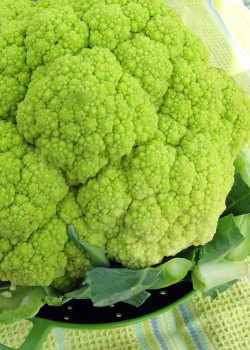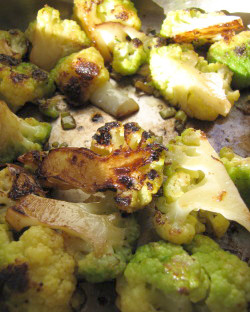 I’ve always been a sucker for colorful vegetables. But hand me another dark, drizzly day, and you’ll find me going gaga at the grocery store for anything chartreuse…or fuchsia…or sunset orange. I need the color to stimulate my senses.
I’ve always been a sucker for colorful vegetables. But hand me another dark, drizzly day, and you’ll find me going gaga at the grocery store for anything chartreuse…or fuchsia…or sunset orange. I need the color to stimulate my senses.
But sometimes I get myself in trouble. Take this whole green cauliflower thing. I love this stuff, which I happen to call Broccoflower®. Because that’s what it’s labeled at my grocery store. I included a side dish recipe for it in Fast, Fresh & Green, and developed a pasta recipe with it for my next book. The problem came when I asked my cross-testers, Jessica and Eliza, to go find Broccoflower in their grocery stores. Initially they both said they couldn’t find it. But both had the presence of mind to call me from the grocery store and describe what they did see. So after cell-phone exchanges and emailed photos, we determined that what both of them found was a very similar vegetable labeled “green cauliflower.”
It turns out that Broccoflower® is a registered trademark of Tanimura & Antle, a produce company that brought the variety (a cauliflower with some broccoli genes) over from Holland more than 20 years ago. Tanimura & Antle also has an orange cauliflower they call “Fiestaflower.” Meanwhile, another big produce company, Andy Boy, has begun marketing green cauliflower, orange cauliflower, and purple cauliflower in the last few years under those basic names. (All of these are purported to have the antioxidants you’d expect would pair with those colors.) As far as I can tell, Broccoflower and green cauliflower are virtually the same thing. Whew. I was getting a little worried that I’d have to take the new recipe out of the book.
 It’s not just the color of green cauliflower (aka Broccoflower) that I love. To my palate, it tastes a bit less cabbagey and a tad sweeter than white cauliflower. And when you cut it, the stems are a bit firmer—more broccoli-esque. And in general, I think it holds up better in cooking. Its florets are firmer than those of cauliflower, which can get a bit crumbly.
It’s not just the color of green cauliflower (aka Broccoflower) that I love. To my palate, it tastes a bit less cabbagey and a tad sweeter than white cauliflower. And when you cut it, the stems are a bit firmer—more broccoli-esque. And in general, I think it holds up better in cooking. Its florets are firmer than those of cauliflower, which can get a bit crumbly.
Green cauliflower caramelizes beautifully in the sauté pan or roasting pan, so if you find some, crank up the heat. Then treat it to lemon, garlic (or another allium like scallions or leeks), and Parmigiano—three flavors it loves. (I’ve included a sample side dish recipe, below.)
Serve it with roast pork or chicken, or turn it into a pasta sauce with a little chicken broth or pasta-cooking water and more olive oil or butter. It’s pretty darn tasty, which shouldn’t be surprising—I find the most colorful veggies taste the best, too.
Lemony Green Cauliflower with Scallions & Parmigiano
For this recipe, cut the florets on the small side—no more than about 1 1/2 inches long. It also helps browning if you cut whole florets in half—that cut side will have maximum contact with the hot pan and get very caramelized (see photo). Feel free to adjust the amount of lemon (or add a bit of lemon zest) here. And if you want a slightly saucier dish, deglaze the pan (to scrape up the flavorful browned bits) by pouring a bit more chicken broth, water, or wine (diluted) in at the end. You can also enhance the sauce with a bit more cold butter.
2 tablespoons low-sodium chicken broth or water
3 teaspoons fresh lemon juice
12 ounces (3/4 pound) green cauliflower florets (a little less than one small head, cut into small florets)
2 tablespoons unsalted butter
1 tablespoon extra-virgin olive oil
1 teaspoon kosher salt
1/4 cup sliced scallions (white and light green parts only) plus 1 tablespoon sliced green tops for garnish
2 tablespoons coarsely grated Parmigiano Reggiano (I use a food processor to chop coarsely)
Combine the chicken broth or water with 2 teaspoons of the lemon juice and put it near your stove. In a 10-inch (3-quart) straight-sided stainless steel sauté pan, heat the olive oil and 1 tablespoon of the butter over medium heat. When the butter has melted, add the green cauliflower florets and the salt and toss and stir well. (A silicone spoonula works well for this.) Cover the pan and cook, stirring occasionally, until all the florets are browned in places, about 6 to 7 minutes. (There will be moisture accumulating inside the lid and it will drip down to deglaze the pan a little bit. But don’t worry if the pan is getting brown.)
Uncover, carefully pour in the chicken broth or water and lemon mixture, and immediately put the lid back on (beware of steam). Cook until most of the liquid has steamed off or been absorbed, about 30 seconds. Uncover, turn the heat to low, and add the remaining tablespoon of butter, the remaining teaspoon of lemon juice, and the scallions. Cook, stirring gently, until the butter has melted and the scallions have softened, 1 to 2 minutes.
Remove the pan from the heat and transfer all the green cauliflower and scallions to a serving dish or dishes. Sprinkle with the Parmigiano and the scallion tops and serve.
Serves 3
Susie Middleton is the author of Fast, Fresh & Green, a cookbook of delicious vegetable side dishes (Chronicle Books, April 2010). She is the former Editor and current Editor at Large for Fine Cooking magazine. She lives, writes, cooks, and grows vegetables on Martha's Vineyard. Her blog is at <sixburnersue.com

